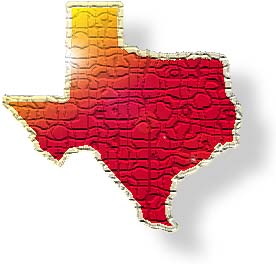 Once,
someone who was new to Texas said, "Oh, don’t
tell me again that Texas is such a big State!" The
trouble is that Texas has some 267,399 square mile and
stretches 773 miles from east to west and 860 miles from
south to north.
Once,
someone who was new to Texas said, "Oh, don’t
tell me again that Texas is such a big State!" The
trouble is that Texas has some 267,399 square mile and
stretches 773 miles from east to west and 860 miles from
south to north.
With that much land mass, and with
more surface-acres of water than Minnesota, Texas
encompasses wildly divergent natural areas. The
state’s Natural Regions form the basis for almost
every field guide to naturally occurring flora, fauna,
geology and geography. And, the Texas Travel and Tourism
Map, adopted by Texas Parks and Wildlife in cooperation
with the Texas Department of Transportation and the Texas
Department of Commerce, was based loosely on the Natural
Regions.
It’s not an
accident that we use the travel map in the "Passport
Journal", it’s the natural thing to do because
it gives you a hint of the type of vegetation and terrain
you may encounter on any trip!
Here’s a guide
to the Travel Regions with an abbreviated description of
the eleven major Natural Regions that underlie them.
Each major Natural
Region contains subregions and, of course, nature does
not follow the county lines found in most travel maps. On
the INTERNET, check out the Texas Parks & Wildlife
web site under the heading Nature to see a
detailed map of the Natural Regions of Texas.
Panhandle Plains
Rolling Plains
Natural Region with 22 - 30 inches annual rainfall.
Gently rolling grasslands that originally included tall
and midgrasses.
High Plains Natural
Region with 15 - 31 inches annual rainfall. The southern
end of the Great Plains, relatively level high plateau
separated from the Rolling Plains by the Caprock
Escarpment - home of the dramatic Caprock Canyons and
Palo Duro Canyon state parks.
Big Bend Country
Trans-Pecos Natural
Region with less than 12 inches annual rainfall. The most
complex Natural Region, it includes Sand Hills, the
Stockton Plateau, desert valleys, wooded mountain slopes
and desert grasslands.
Hill Country
Edwards Plateau
Natural Region with 15 - 33 inches annual rainfall.
Several rivers cut canyon lands here creating a rough
landscape dominated by ash, juniper, Texas and stunted
live oak trees.
Llano Uplift Natural
Region with 30 inches annual rainfall. Home to the
Enchanted Rock SNA, the uplift contains other granite
exfoliation domes.
South Texas Plains
South Texas Brush
Country Natural Region with 16 - 35 inches annual
rainfall. Level to rolling land with thorny brush and
with a greater diversity of animal life than any other
place in Texas. It is home for many near-tropical
species, many grassland species and some desert species.
Gulf Coast
Coastal Sand Plains
Natural Region with 35 - 45 inches annual rainfall.
Fairly level windblown sands and dunes with grasslands,
oak mottes and salt marshes.
Gulf Prairies and
Marshes Natural region with 20 - 50 inches annual
rainfall. This is a nearly level, slowly drained plain
dissected by streams and rivers which flow into highly
productive estuaries and marshes.
Prairies & Lakes
Oakwoods and
Prairies Natural Region with 35 - 45 inches annual
rainfall. Oak - hickory forest broken up with fingers of
tall-grass prairies. Peat bogs and marshes, river valleys
with forests of hackberries and pecans.
Blacklands Prairies
Natural Region with 30 - 40 inches annual rainfall.
Gently rolling to nearly level grasslands with dark
alkaline clays often called "black gumbo".
Rivers in these two
Natural Regions have been dammed creating a multitude of
manmade lakes.
Pineywoods
Pineywoods Natural
Region with 35 - 50 inches annual rainfall. Gently
rolling to hilly forested land, part of a larger
pine-hardwood forest that extends into Louisiana,
Arkansas and Oklahoma.
Gus Engeling WMA
(Wildlife Management Area)
Historically, Gus
Engeling’s mature uplands of oaks, hickories, elm
and gum were never extensively cut but an understory was
allowed to encroach. Now, nearly 50 years of conservation
management have restored 500 acres of uplands to their
original savanna state.
The Engeling WMA
also claims over 3,000 acres of prime wetland habitats
including hardwood-bottomland floodplain, riparian
corridors, marshes, swamps, bogs and beaver ponds.
Beavers play an
active role here in creating wetlands with their
tree-felling and dam building activities.
"In East Texas, hardwood-bottomlands
are the axis from which many wild animals move to uplands,"
said Hayden Hauck, area manager. "without these hardwood-wetland
systems, many wildlife populations in east Texas would deteriorate
in number and kind. They are, without a doubt, the single most important
wildlife habitat type in East Texas."


